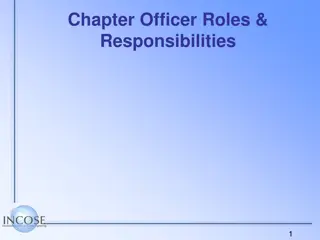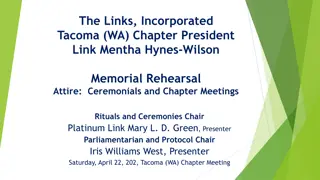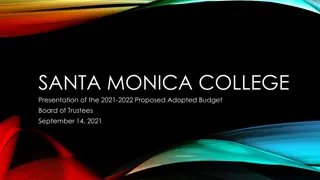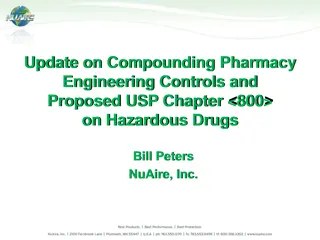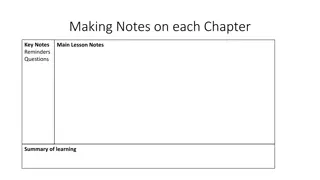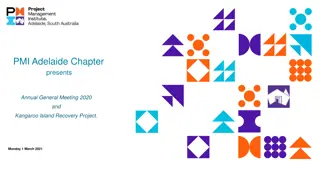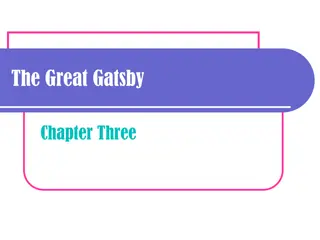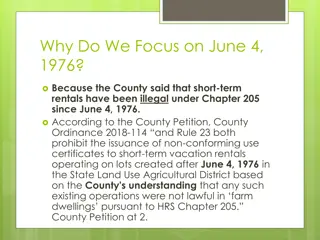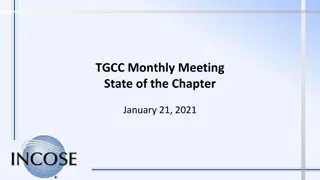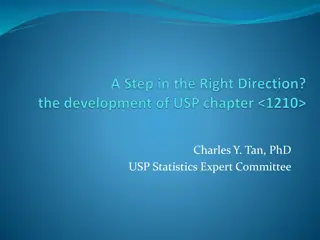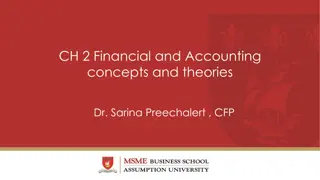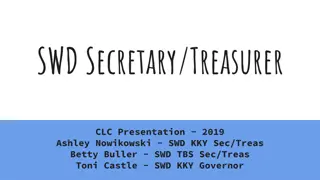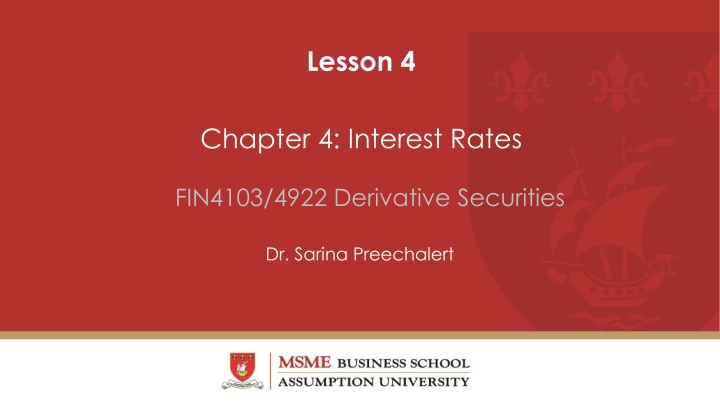
Interest Rates and Their Impact on Derivative Securities
Explore the different types of interest rates, including Treasury rate, LIBOR, Fed funds rate, and repo rate, and learn how they are used in the world of derivative securities. Discover how interest rates are measured, compounded, and their effects on investments. Dive into the intricacies of compounding frequencies and their significance in financial calculations.
Download Presentation

Please find below an Image/Link to download the presentation.
The content on the website is provided AS IS for your information and personal use only. It may not be sold, licensed, or shared on other websites without obtaining consent from the author. If you encounter any issues during the download, it is possible that the publisher has removed the file from their server.
You are allowed to download the files provided on this website for personal or commercial use, subject to the condition that they are used lawfully. All files are the property of their respective owners.
The content on the website is provided AS IS for your information and personal use only. It may not be sold, licensed, or shared on other websites without obtaining consent from the author.
E N D
Presentation Transcript
Lesson 4 Chapter 4: Interest Rates FIN4103/4922 Derivative Securities Dr. Sarina Preechalert
Types of Rates 1. Treasury rate 2. LIBOR 3. Fed funds rate 4. Repo rate 2
1. Treasury Rate Rate on instrument issued by a government in its own currency 3
2. LIBOR LIBOR is the rate of interest at which a AA bank can borrow money on an unsecured basis from another bank For 10 currencies and maturities ranging from 1 day to 12 months it is calculated daily by the British Bankers Association from submissions from a number of major banks There have been some suggestions that banks manipulated LIBOR during certain periods. Why would they do this? 4
3. The Fed Funds Rate Unsecured interbank overnight rate of interest Allows banks to adjust the cash (i.e., reserves) on deposit with the Federal Reserve at the end of each day The effective fed funds rate is the average rate on brokered transactions The central bank may intervene with its own transactions to raise or lower the rate 5
4. Repo Rate Repurchase agreement is an agreement where a financial institution that owns securities agrees to sell them for X and buy them back in the future (usually the next day) for a slightly higher price, Y The financial institution obtains a loan. The rate of interest is calculated from the difference between X and Y and is known as the repo rate 6
Measuring Interest Rates The compounding frequency used for an interest rate is the unit of measurement The difference between quarterly and annual compounding is analogous to the difference between miles and kilometers 7
Impact of Compounding When we compound m times per year at rate R an amount A grows to A(1+R/m)min one year Compounding frequency Value of $100 in one year at 10% 110.00 110.25 110.38 110.47 110.51 110.52 Annual (m=1) Semiannual (m=2) Quarterly (m=4) Monthly (m=12) Weekly (m=52) Daily (m=365) 8
Continuous Compounding In the limit as we compound more and more frequently we obtain continuously compounded interest rates $100 grows to $100eRTwhen invested at a continuously compounded rateRfor time T $100 received at time Tdiscounts to $100e-RTat time zero when the continuously compounded discount rate is R 9
Conversion Formulas Define Rc : continuously compounded rate Rm: same rate with compounding m times per year R m m = + ln 1 R m c ( ) R m c / = 1 R m e m 10
Examples 10% with semiannual compounding is equivalent to 2ln(1.05)=9.758% with continuous compounding 8% with continuous compounding is equivalent to 4(e0.08/4 -1)=8.08% with quarterly compounding Rates used in option pricing are nearly always expressed with continuous compounding 11
Zero Rates A zero rate (or spot rate), for maturity T is the rate of interest earned on an investment that provides a payoff only at time T Example Maturity (years) Zero rate (cont. comp.)% 5.0 5.8 6.4 6.8 0.5 1.0 1.5 2.0 12
Bond Pricing To calculate the cash price of a bond we discount each cash flow at the appropriate zero rate In our example, the theoretical price of a two-year bond providing a 6% coupon semiannually is 0 05 0 5 . + + . 0 058 10 . . 0 064 15 . . 3 3 3 e e e + = 0 068 2 0 . . 103 9839 . e 13
Bond Yield The bond yield is the discount rate that makes the present value of the cash flows on the bond equal to the market price of the bond Suppose that the market price of the bond in our example equals its theoretical price of 98.39 The bond yield (continuously compounded) is given by solving + + + = 0 5 . 1 0 . 15 . 2 0 . y y y y 3 3 3 103 9839 . e e e e to get y=0.0676 or 6.76%. 14
Par Yield The par yield for a certain maturity is the coupon rate that causes the bond price to equal its face value. In our example we solve c c c 0 05 . 0 5 0 058 1 0 0 064 . 1 5 . . . . + + e e e 2 2 + 2 c 0 068 2 0 . . + = 100 100 e 2 get to 6 semiannual (with 87 . compoundin g) c= 15
Par Yield continued In general if mis the number of coupon payments per year, d is the present value of $1 received at maturity and A is the present value of an annuity of $1 on each coupon date ( 100 100 = ) d m c A (in our example, m= 2, d = 0.87284, and A = 3.70027) 16
Data to Determine Zero Curve FIND r for each bond? Bond Principal Time to Maturity (yrs) 0.25 0.50 1.00 1.50 2.00 Coupon per year ($)* 0 0 0 8 12 Bond price ($) 97.5 94.9 90.0 96.0 101.6 100 100 100 100 100 * Half the stated coupon is paid each year 17
The Bootstrap Method An amount 2.5 can be earned on 97.5 during 3 months. Because 100=97.5e0.10127 0.25 the 3-month rate is 10.127% with continuous compounding Similarly the 6 month and 1 year rates are 10.469% and 10.536% with continuous compounding 18
The Bootstrap Method continued To calculate the 1.5 year rate we solve 10469 . 0 5 . 0 10536 . 0 0 . 1 5 . 1 + + = R 4 4 104 96 e e e to get R = 0.10681 or 10.681% Similarly the two-year rate is 10.808% Show the Two-year rate equation. 19
Zero Curve Calculated from the Data 12 Zero Rate (%) 11 10.808 10.681 10.536 10.469 10 10.127 9 0 0.5 1 1.5 2 2.5 Maturity (yrs) 20
Forward Rates The forward rate is the future zero rate implied by today s term structure of interest rates 21
Formula for Forward Rates Suppose that the zero rates for time periods T1and T2are R1 and R2 with both rates continuously compounded. The forward rate for the period between times T1 and T2 is R T 2 R T T 1 2 1 1 T 2 This formula is only approximately true when rates are not expressed with continuous compounding 22
Application of the Formula Year (n) Zero rate for n-year investment (% per annum) 3.0 4.0 4.6 5.0 5.5 Forward rate for nth year (% per annum) R T 2 R T T 1 1 2 3 4 5 2 1 1 5.0 5.8 6.2 6.5 T 2 23
Upward vs Downward Sloping Yield Curve For an upward sloping yield curve: Fwd Rate > Zero Rate > Par Yield For a downward sloping yield curve Par Yield > Zero Rate > Fwd Rate 24
Forward Rate Agreement A forward rate agreement (FRA) is an OTC agreement that a certain rate will apply to a certain principal during a certain future time period 25
Forward Rate Agreement: Key Results An FRA is equivalent to an agreement where interest at a predetermined rate, RK is exchanged for interest at the market rate An FRA can be valued by assuming that the forward LIBOR interest rate, RF , is certain to be realized This means that the value of an FRA is the present value of the difference between the interest that would be paid at interest at rate RF and the interest that would be paid at rate RK 26
Valuation Formulas If the period to which an FRA applies lasts from T1 to T2, we assume that RF and RKare expressed with a compounding frequency corresponding to the length of the period between T1 and T2 With an interest rate of RK, the interest cash flow is RK (T2 T1) at time T2 With an interest rate of RF, the interest cash flow is RF(T2 T1) at time T2 27
Valuation Formulas continued When the rate RK will be received on a principal of L the value of the FRA is the present value of )( ( 1 2 T T R R F K ) received at time T2 When the rate RK will be received on a principal of L the value of the FRA is the present value of ) )( ( 1 2 T T R R K F received at time T2 28
Formulas VFRA where Rk is received = L(Rk Rf)(T2 T1)e-R2T2 L = Principal Rk = Fixed rate of FRA Rf = LIBOR Floating rate of FRA R2 = continuously compounded riskless zero rate at T2 VFRA where Rk is paid = L(Rf Rk)(T2 T1)e-R2T2 29
Payoff FRA PAYOFF L(Rm Rk)(T2 T1) / 1+Rm (T2-T1) L(Rk Rm)(T2 T1) / 1+Rm (T2-T1) Rm = Actual LIBOR Interest Rk = Fixed rate agreed on FRA L = Principal underlying contract 30
Example An FRA entered into some time ago ensures that a company will receive 4% (s.a.) on $100 million for six months starting in 1 year Forward LIBOR for the period is 5% (s.a.) The 1.5 year rate is 4.5% with continuous compounding The value of the FRA (in $ millions) is 0 045 . 1 5 . VFRA where Rk is received = L(Rk Rf)(T2 T1)e-R2T2 = 100 0 04 . 0 05 . 0 5 . 0 467 . ( ) e 31
Example continued If the six-month interest rate in one year turns out to be 5.5% (s.a.) there will be a payoff (in $ millions) of = 100 0 04 . 0 055 . 0 5 . 0 75 . ( ) L(Rk Rm)(T2 T1) / 1+Rm (T2-T1) 0 75 . = 0 730 . 1 0275 . Payoff in 1.5 years = -0.75 The transaction might be settled at the one-year point for an equivalent payoff of = -0.730 32
Duration Duration of a bond that provides cash flow ciat time ti is = D yt n c e i = i i t i B 1 where B is its price and y is its yield (continuously compounded) 33
Key Duration Relationship Duration is important because it leads to the following key relationship between the change in the yield on the bond and the change in its price B = D y B 34
Key Duration Relationship continued When the yield y is expressed with compounding m times per year B = BD + 1 y y m The expression D y m 1+ is referred to as the modified duration 35
Bond Portfolios The duration for a bond portfolio is the weighted average duration of the bonds in the portfolio with weights proportional to prices The key duration relationship for a bond portfolio describes the effect of small parallel shifts in the yield curve What exposures remain if duration of a portfolio of assets equals the duration of a portfolio of liabilities? 36
Convexity The convexity, C, of a bond is defined as n = 2 yt c t e i i i 2 1 B 2 1 = = i C B B y This leads to a more accurate relationship 1 B ( )2 = + D y C y 2 B When used for bond portfolios it allows larger shifts in the yield curve to be considered, but the shifts still have to be parallel 37
Theories of the Term Structure Expectations Theory: forward rates equal expected future zero rates Market Segmentation: short, medium and long rates determined independently of each other Liquidity Preference Theory: forward rates higher than expected future zero rates 38
Liquidity Preference Theory Suppose that the outlook for rates is flat and you have been offered the following choices Maturity 1 year 5 year Deposit rate 3% 3% Mortgage rate 6% 6% Which would you choose as a depositor? Which for your mortgage? 39
Liquidity Preference Theory To match the maturities of borrowers and lenders a bank has to increase long rates above expected future short rates In our example the bank might offer Maturity Deposit rate Mortgage rate 1 year 3% 6% 5 year 4% 7% 40

